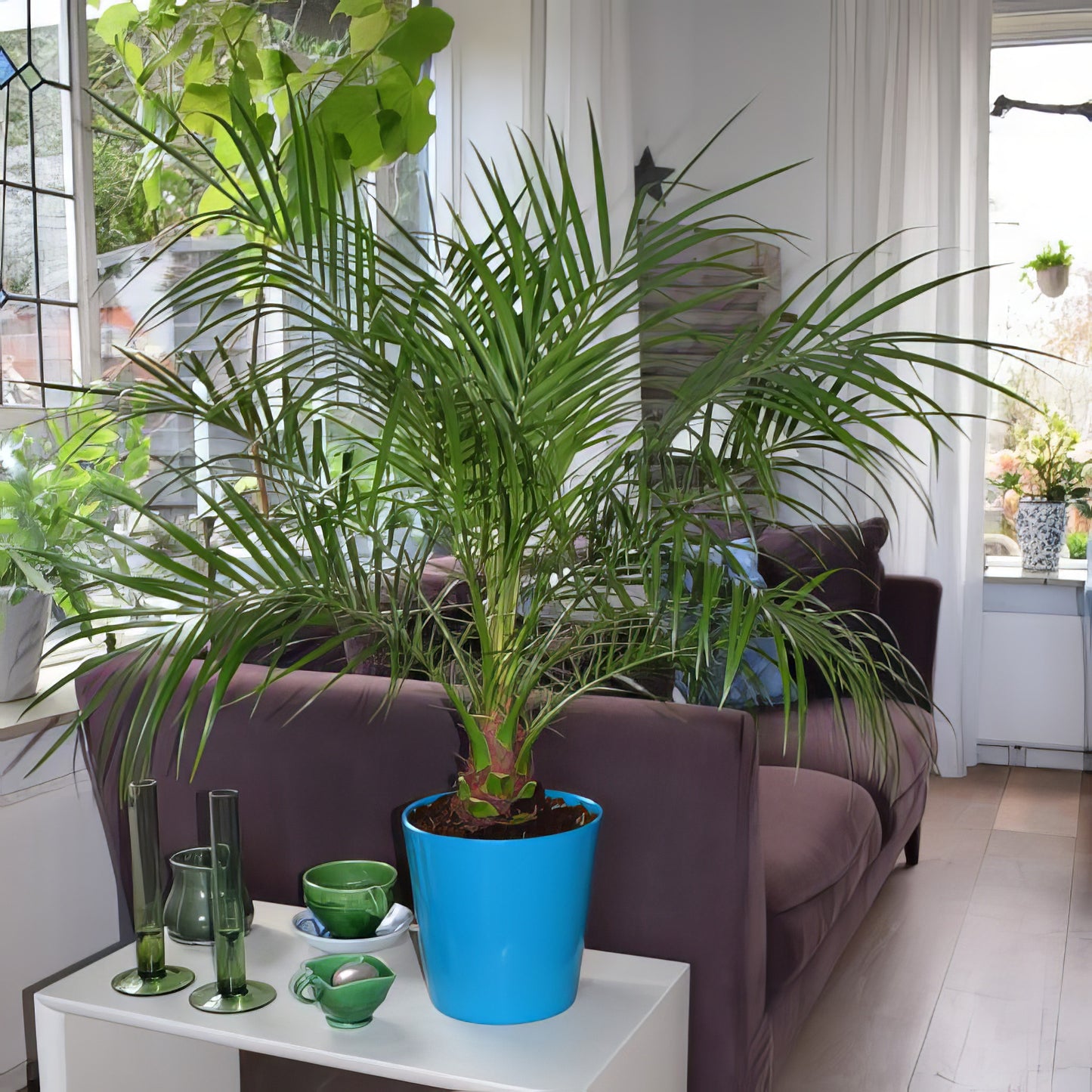VIRIAR
Phoenix roebelenii - Zwergdattelpalme - 20 x frische Samen
Phoenix roebelenii - Zwergdattelpalme - 20 x frische Samen
Verfügbarkeit für Abholungen konnte nicht geladen werden
Pflanzenbeschreibung
Name: Phoenix roebelenii
Allgemeiner Name: Zwergdattelpalme, Robellini-Palme
Phoenix roebelenii , allgemein bekannt als Zwergdattelpalme oder Robellini-Palme, ist eine beliebte Zwergpalme, die für ihr attraktives Aussehen und ihre kompakte Größe bekannt ist. Diese Palme stammt ursprünglich aus Südchina und Nordlaos und wird aufgrund ihrer eleganten, federähnlichen Wedel und ihrer Fähigkeit, sowohl im Innen- als auch im Außenbereich zu gedeihen, häufig in der Landschaftsgestaltung verwendet.
Phoenix roebelenii erreicht normalerweise eine Höhe von 1,5 bis 3 Metern und eignet sich daher gut für kleinere Gärten oder als Zimmerpflanze. Die Palme hat einen schlanken, aufrechten Stamm, der mit einem feinen Netzwerk aus alten Blattbasen bedeckt ist. Die Krone ist mit federartigen, gefiederten Wedeln geschmückt, die bis zu 1,5 Meter lang werden können. Die Wedel haben eine satte grüne Farbe und sorgen für ein üppiges, tropisches Aussehen. Im Spätsommer bringt der Baum kleine, unauffällige Blüten hervor, die sich zu winzigen, ungenießbaren Datteln entwickeln können.
Die Zwergdattelpalme wird wegen ihrer Vielseitigkeit, Pflegeleichtigkeit und dekorativen Wirkung geschätzt und ist daher sowohl für den Innen- als auch für den Außenbereich beliebt.
Anbau von Phoenix roebelenii
Bedingungen:
- Licht: Phoenix roebelenii gedeiht bei hellem, indirektem Licht, wenn sie im Haus wächst. Sie kann sich auch an Halbschatten gewöhnen, wenn sie im Freien wächst, aber am besten gedeiht sie mit etwas direktem Sonnenlicht. Wenn sie im Haus wächst, ist es ideal, die Palme in die Nähe eines hellen Fensters zu stellen.
- Temperatur: Diese Palme ist am besten für die USDA-Winterhärtezonen 9b-11 geeignet. Sie bevorzugt warme Temperaturen und ist frostempfindlich. Sie verträgt Temperaturen bis zu -5 °C (23 °F), sollte jedoch vor kalter Zugluft und Minustemperaturen geschützt werden.
- Boden: Phoenix roebelenii bevorzugt gut entwässernden Boden, beispielsweise eine sandige oder lehmige Mischung. Sie verträgt eine Reihe von Bodenarten, benötigt aber eine gute Entwässerung, um Wurzelfäule zu verhindern. Ein pH-Bereich von 6,0 bis 7,5 ist ideal.
- Wasser: Gießen Sie die Palme regelmäßig, damit die Erde gleichmäßig feucht bleibt. Lassen Sie die obersten 2,5 cm der Erde zwischen den Wassergaben austrocknen. Vermeiden Sie zu viel Wasser, da dies zu Wurzelfäule führen kann. Die Palme ist relativ trockenheitsresistent, profitiert aber von gleichmäßiger Feuchtigkeit, insbesondere während der Wachstumsperiode.
Pflanzung und Pflege:
- Pflanzen: Wählen Sie einen Standort mit hellem, indirektem Licht für Zimmerpflanzen oder Halbschatten für Außenpflanzen. Verwenden Sie für Zimmerpflanzen einen Topf mit Abflusslöchern. Graben Sie beim Pflanzen im Freien ein Loch, das doppelt so breit ist wie der Wurzelballen, und pflanzen Sie die Palme in derselben Tiefe ein, in der sie im Topf war. Nach dem Pflanzen gründlich gießen.
- Düngung: Düngen Sie Phoenix roebelenii mit einem ausgewogenen, langsam freisetzenden Dünger für Palmen oder tropische Pflanzen. Wenden Sie den Dünger im Frühjahr und Sommer gemäß den Anweisungen des Herstellers an. Reduzieren Sie die Düngung im Herbst und Winter, wenn das Wachstum der Pflanze nachlässt.
- Pflege: Zur regelmäßigen Pflege gehört das Entfernen abgestorbener oder vergilbter Wedel und die Kontrolle auf Schädlinge wie Spinnmilben oder Schildläuse. Beschneiden Sie die Pflanze nur, wenn es nötig ist, um Form und Gesundheit der Pflanze zu erhalten. Reinigen Sie die Wedel mit einem feuchten Tuch, um Staub zu entfernen und dafür zu sorgen, dass die Pflanze immer gut aussieht.
Vermehrung
- Samen: Phoenix roebelenii kann aus Samen vermehrt werden. Weichen Sie die Samen 24–48 Stunden in Wasser ein, um die Samenschale aufzuweichen. Säen Sie die Samen in eine gut entwässernde Blumenerde und halten Sie sie warm und feucht. Die Keimung kann mehrere Wochen bis Monate dauern.
- Ableger: Die Palme kann auch Ableger (Wurzeln) um die Basis des Stammes herum bilden, die abgetrennt und verpflanzt werden können, um neue Palmen zu züchten. Stellen Sie vor dem Verpflanzen sicher, dass jeder Ableger eigene Wurzeln hat.







